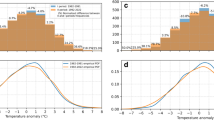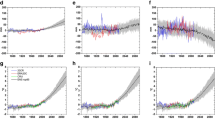Summary
The amplitude and spatial structure of the temperature fluctuations of three stratospheric layers (10–30 mb, 30–50 mb and 50–100 mb) were examined on a global scale. Some new facts emerge which shed light on the general circulation of the stratosphere and which may be summarized as follows: (a) The quasi-biennial temperature oscillation (QBO) in the equatorial region (10 N) has a longer period than that in the latitude belt 20 N to 40 N. (b) The semiannual temperature oscillation (SAO) at low latitude has a relatively large ampltitude but the variance is distributed over a range of frequencies not centered in a line. The SAO disappears at 30 N then reemerges at 40 N and increases to a maximum at sub-polar latitudes. At 50 N the SAO appears to be caused by the variation in the eddy exchange process from the winter to the summer season. In polar regions the SAO disappears in a background variance that is distributed over all the higher frequencies. (c) The background variance at periods less than one year increases with latitude and altitude to the north of 40 N and accounts for more than 10% of the total variance in polar regions. (d) Global fluctuations of stratospheric temperatures on time scales of a decade or more are discussed and possible causes are advanced.
Zusammenfassung
Es werden die Amplitude und die räumliche Struktur der Temperaturschwankungen von drei Stratosphärenschichten (10–30 mb, 30–50 mb und 50–100 mb) in globalem Ausmaß untersucht. Es ergeben sich neue Tatsachen, die ein Licht auf die allgemeine Zirkulation der Stratosphäre werden und die, wie folgt, zusammengefaßt werden können: a) Die quasibiennale Temperaturschwankung (QBO) weist in der äquatorialen Region (10°N) eine längere Periode auf als im Breitengürtel von 20 bis 40°N. b) Die halbjährige Temperaturschwankung (SAO) hat in niedriger Breite eine relativ große Amplitude, aber die Varianz ist über eine Bande von Frequenzen verteilt und nicht auf eine einzige Linie konzentriert. Die SAO verschwindet in 30°N, erscheint dann in 40°N wieder und nimmt bis zu einem Maximum in subpolaren Breiten zu. Es hat den Anschein, daß in 50°N die SAO durch die Änderung der zyklonalen Austauschprozesse vom Winter zum Sommer verursacht wird. In den polaren Regionen verschwindet die SAO in einer Grundvarianz, die über alle höheren Frequenzen verteilt ist. c) Die Grundvarianz nimmt bei Perioden kleiner als ein Jahr mit der Breite und Höhe bis 40°N zu und macht mehr als 10% der Gesamtvarianz in polaren Gebieten aus. d) Globale Schwankungen der Temperatur der Stratosphäre in Periodenlängen von einer Dekade oder mehr werden besprochen und mögliche Ursachen dafür werden vorgebracht.
Similar content being viewed by others
References
Angell, J. K., Korshover, J.: Quasi-Biennial Variations in Temperature, Total Ozone and Tropopause Heights. J. Atmos. Sci.21, 479–492 (1964).
Angell, J. K., Kroshover, J.: Quasi-Biennial Annual and Semiannual Zonal Wind and Temperature Harmonic Amplitudes and Phases in the Stratosphere and Low Mesosphere of the Northern Hemisphere. J. Geophys. Res.75, 543–550 (1970).
Blackman, R. B., Tukey, J. W.: The Measurement of Power Spectra. 190 pp. Dover New York 1959.
Dartt, D. G., Belmont, A. D.: A Global Analysis of the Variability of the Quasi-Biennial Oscillation. Quart. J. R. Met. Soc.96, 186–194 (1970).
Dopplick, T. G.: Radiative Heating of the Global Atmosphere. J. Atmos. Sci.29, 1278 (1972).
Jenne, R. L.: Data Sets for Meteorological Research, NCAR Tech. Note, TN/1A-111, Boulder, Colorado 1975.
Julian, P. R.: Comments on the Determination of Significance Levels of the Coherence Statistic. J. Atmos. Sci.32, 836–837 (1975).
Kriester, B.: Änderungen von stratosphärischen Druckflächen im Zusammenhang mit der Sonnenaktivität. Met. Rdsch.24, 71–73 (1971).
Labitzke, K.: Interannual Variability of the Winter Stratosphere in the Northern Hemisphere. Mon. Weath. Rev.105, 762–770 (1977).
Labitzke, K.: Climatology of the Stratosphere in the Northern Hemisphere. Part 1: Heights, Temperatures and Geostrophic Resultant Wind Speeds at 100, 50, 30 and 10 mb. Inst. für Meteorologie, Freie Univ. Berlin, Meteorol. Abhandl.100, 4 (1972).
Lorenz, E. N.: The Nature and Theory of the General Circulation of the Atmosphere. WMO No. 218, Geneva 1968.
Louis, J. F.: A Two-Dimensional Transport Model of the Atmosphere. Ph. Dr. thesis, University of Colorado, 1974.
Nastrom, G. D., Belmont, A. D.: Periodic Variations in Stratospheric-Meospheric Temperature From 20–65 km at 80 N to 30 S. J. Atmos. Sci.32, 1715–1722 (1975).
Quiroz, R. S.: The Determination of the Amplitude and Altitude of Stratospheric Warmings From Satellite-Measured Radiance Changes. J. Appl. Met.10, 555–574 (1970).
Reed, R. J., Campbell, W. J., Rasmussen, L. A., Rogers, D. G.: Evidence of a Downward-Propagating Annual Wind Reversal in the Equatorial Stratosphere. J. Geophys. Res.66, 813–818 (1961).
Reed, R. J.: Some Features of the Annual Temperature Regime in the Tropical Stratosphere. Mon. Weath. Rev.90, 211–215 (1962).
Rosen, R. D., Wu, M. F., Peixoto, J. P.: Observational Study of the Interannual Variability in Certain Features of the General Circulation. J. Geophys. Res.81, 6383–6389 (1976).
Sekihara, K., Ikeda, H., Kiguchi, N., Tamura, T.: A Long-Term Trend of Stratospheric Temperatures. Coll. of Extended Summaries, CMUA Sessions IAGA/IAMAP. 22 Aug.—3 Sept. 1977, Washington, Seattle, 37, 1–37, 6, Boulder, Colorado 1977.
Van Loon, H., Labitzke, K., Jenne, R. L.: Half-Yearly Wave in the Stratosphere. J. Geophys. Res.77, 3846–3855 (1972).
Van Loon, H., Labitzke, K., Jenne, R. L.: A Note on the Annual Temperature Wave in the Stratosphere. J. Geophys. Res.78, 2672–2678 (1973).
Veryard, R. G., Ebdon, R. A.: Fluctuations in Tropical Stratospheric Winds. Met. Mag.90, 125–143 (1961).
Warnecke, G.: Über die Zustandsänderungen der nordhemisphärischen Stratosphäre. Meteorol. Abhandl., Freie Univ. Berlin28, 3 (1962).
Zerefos, C. S., Crutzen, P. J.: Stratospheric Thickness Variation Over the Northern Hemisphere and Their Possible Relation to Solar Activity. J. Geophys. Res.80, 5041–5043 (1975).
Zerefos, C. S., Mantis, H. T.: Climatic Fluctuations in the Northern Hemisphere Stratosphere. Arch. Met. Geoph. Biokl., Ser. B25, 33–39 (1977).
Author information
Authors and Affiliations
Additional information
With 9 Figures
Rights and permissions
About this article
Cite this article
Mantis, H.T., Zerefos, C.S. Fluctuations in the Northern Hemisphere stratospheric temperature on time scales from ten years to two months. Arch. Met. Geoph. Biokl. A. 28, 127–147 (1979). https://doi.org/10.1007/BF02310161
Received:
Issue Date:
DOI: https://doi.org/10.1007/BF02310161




